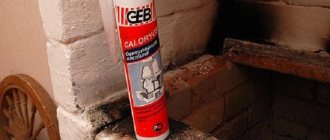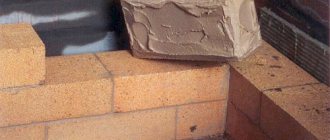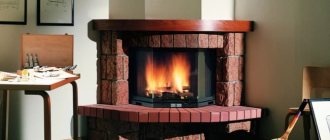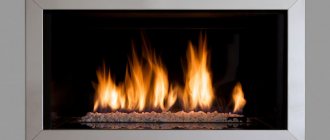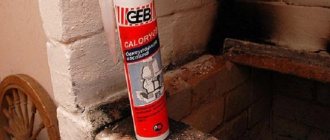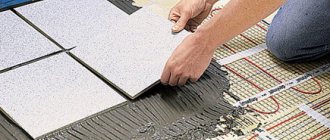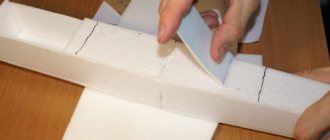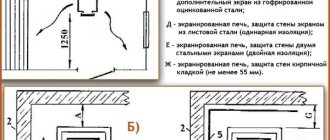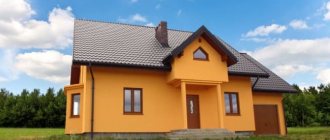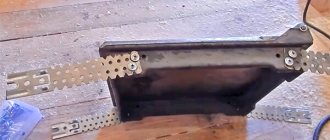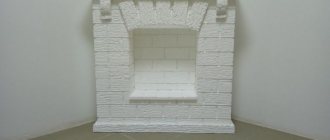Compound
Each oven adhesive contains the following substances:
- Sand.
- Cement.
- Synthetic and mineral components.
- Fibers.
Manufacturers try to improve the characteristics of the compositions by adding various substances, leaving the glue as versatile as possible.
Important! Fireclay fibers provide resistance to extreme temperatures, and they also provide heat resistance. But there is one important point here: you need to glue it the first time, if there are shifts, the glue will lose important qualities.
Requirements for compositions for furnace lining
Standard tile adhesive is not suitable for finishing surfaces that are in close proximity to fire. The material will be constantly exposed to temperatures. You need to choose a heat-resistant, durable glue. Otherwise, changes will occur that will lead to deformation.
When choosing a lining for a stove, it is important to focus on the following characteristics:
- Heat resistance.
- High level of adhesion.
- Safety.
- Elasticity of the adhesive.
Heat resistance
You can find out that the mixture is heat-resistant from the information on the packaging. However, ordinary high-temperature compounds, which are used in conditions up to 50 degrees, should not be confused with heat-resistant ones. Glue for fireplaces must retain its quality at +175 degrees and temporary heating up to +1200 degrees. On the packaging, in addition to this indicator, it is said that it is suitable specifically for stoves and other heated surfaces.
Adhesion level
Furnaces are finished with high-adhesion ceramics. Its thickness is not less than 0.8 cm. To fix the cladding, a composition with a high level of adhesion must be used, otherwise strong fixation cannot be achieved.
Increased elasticity
Under the influence of extreme conditions, materials deform, decrease or increase. Once cured, the adhesive must remain flexible enough to compensate for the difference in expansion.
To lay ceramics on the stove, you cannot use glue intended for other materials (brick). The reinforcing substances in it prevent expansion.
Safety
Exposure to temperature deforms and leads to the destruction of components and the release of toxic elements. Heat-resistant adhesive must not contain harmful gases.
Choosing heat-resistant adhesive for lining stoves and fireplaces
Adhesive for lining stoves and fireplaces must be resistant to temperature changes, flexible, and durable. Regular tile adhesive will not withstand the temperature effects of fire, as a result of which the surface will be deformed.
Heat-resistant glue can be liquid and dry (with further mixing). Liquid glue is best used by professionals, since it dries quickly, and the dry mixture is easier to work with for beginners, since it needs to be mixed as the work progresses.
Criterias of choice
When choosing adhesive for cladding, you need to consider the following indicators:
- Heat resistance - indicated on the glue packaging. Heat-resistant adhesive must withstand up to 120°C;
- High degree of adhesion;
- Safety;
- Moisture resistance (this criterion is important if the stove is located outdoors or in a room with high humidity);
- Elasticity;
- Durability. The longer the service life of the glue, the better it is.
The choice of glue also depends on the finishing material. Each base must have its own glue. Therefore, you need to read the instructions for the adhesive mixture about interaction with specific materials. Heat-resistant glue is applied to the surface in a thin layer. Therefore, if the surface is uneven and there are large differences, then it is better to use thick heat-resistant glue to level the base.
And here is one of the methods of tiling.
Top 5 brands
The adhesive mixture is produced by many construction companies and firms. Basically, they use the same components in the composition, but the quality of production can vary greatly.
To buy the best heat-resistant tile adhesive, you can pay attention to popular brands of solutions:
- Ceresit SM 17. Suitable for cladding made of different materials (except marble).
- Stove maker. Contains a mixture of sand, cement, additives (mineral, synthetic). Cladding work can be carried out at temperatures from -10°C to 35°C.
- Triumph. The composition includes silicate fillers for the viscosity of the mixture. The main advantage of the mixture is the minimum layer thickness. This glue can be used in rooms where it is impossible to create additional loads on supporting structures.
- Ivsil Termix. This glue can withstand temperatures up to 250°C. The basis is aluminate cement. The composition also includes profile chemical fillers.
- Paladium Palatermo. It showed excellent performance when facing with natural or artificial stone, porcelain stoneware, and clinker tiles. The solution remains viable for 3 hours.
Knowing the requirements for heat-resistant adhesive mixtures will help you avoid making mistakes when choosing a solution for masonry or cladding of fireplaces and stoves. Otherwise, an error can lead to deformation of the base, as well as destruction or peeling of the material.
Other selection factors
When purchasing fireproof adhesive for a tile stove, other factors are taken into account:
- Frost resistance is an important factor when the stove is located in a room with non-permanent occupants, when there is a possibility of negative temperatures in winter. If the glue does not have this property, there is a risk of cracking the tiles.
- Material – more durable tiles require adhesive with a higher level of adhesion.
- The cladding factor - stone reduces adhesion, but fireclay brick increases it.
- Operating mode - if the stove is often heated and extinguished, this puts a greater load on the materials than a constantly operating device.
- Additional loads, vibrations. They affect long-term operation and violate the properties of materials.
Based on these factors, you can choose the ideal glue. Of the different options, you need to choose the one that best suits the operating conditions.
General characteristics of heat-resistant adhesives for ovens
The main factor that determines the name of these materials is operation in high temperature conditions, sometimes in direct contact with fire. When used at high temperatures, heat-resistant adhesive must not only resist destruction, but also maintain its functionality.
General requirements for adhesives intended for furnace construction:
- sufficient resistance to high temperatures for a specific purpose;
- safety – absence of harmful emissions into the air;
- sufficient adhesion with high elasticity of the hardened mixture - to effectively neutralize temperature deformations of the furnace materials;
- ease of installation - optimal consistency, durability and curing time.
For reference. The definition of “sufficient resistance” in the first paragraph means that the furnace elements, depending on their location, are exposed to temperatures of different ranges. Therefore, the degree of resistance of the adhesive composition to high temperatures must be no less than that required in a given location.
Types of adhesive mixtures for ovens
Heat-resistant adhesives can be divided into industrial and household. The former are used at temperatures up to 500 degrees, the latter – up to 400 degrees.
Household ones can be purchased in the form of powder and ready-made products. Powder compositions are prepared from refractory cement and fireclay substances. They contain synthetic components, plasticizers, and heat-resistant agents. Mastics are prepared from fire-resistant clay, mineral and synthetic components, and quartz sand. The consumption of such compounds is less, but the price is significantly higher.
All mixtures for stoves available on the market can be divided into three large groups:
- Budgetary funds based on sand, clay, fireclay. This glue is heat resistant, but its adhesion is slightly reduced. Working with such compounds requires certain skills.
- Better compositions based on aluminosilicate cement. They can withstand extreme temperatures, but their service life is reduced due to the presence of liquid glass. Over time, the glue cracks and the seam is broken.
- Expensive heat-resistant compositions based on quartz sand, aluminum cement, soapstone. Withstands up to 1500 degrees. They are characterized by increased adhesion, excellent seam quality, frost resistance, and resistance to water and moisture.
Glue components
The specified properties of the adhesive are ensured by selecting the proportions of its components: filler, binder and plasticizer. The dependence of the properties of the glue on their ratio is nonlinear; Manufacturer researchers are looking for some kind of optimum. Therefore, it makes no sense to “improve” ready-made mixtures by adding, say, a “missing” component to increase fire resistance: in the end the glue will be either bad or completely unsuitable.
In ready-made stove/fireplace adhesives, the base is made up of traces. component:
- Clay-cement binder, sand filler, mineral plasticizer – fireclay fiber. The cheapest, durable, fire and heat resistant, but adhesion is weak. Mainly masonry heat-resistant adhesive for stoves and bases of household heating appliances using solid fuel. Can be used for finishing horizontal and flat surfaces. The main drawback, from the point of view of a beginner, is that the brick or tile must be placed immediately in exactly the same place. If you drag it along the liquid glue, the strength and gas-tightness of the dried seam will decrease several times. Ultimate heat resistance – 1200 degrees.
- The binder is heat-resistant aluminosilicate cement and kaolin, the filler is quartz sand, the mineral plasticizer is liquid glass. Somewhat more expensive than clay-cement-fireclay ones, but they have good adhesion. Fireproof adhesive based on aluminosilicates and kaolin holds up to 1360 degrees. The main disadvantage is the service life of up to 20-25 years. Liquid glass is nothing more than old silicate office glue; it gradually loses its plasticity and crumbles into powder. For the same reason, the initial plasticity of dried aluminosilicate glue is low, but it is quite suitable for finishing tiles or porcelain stoneware on stove bricks.
- The binder and filler are the same, but the mineral plasticizer is soapstone flour. Soapstone, also known as steatite, soapstone, stove stone or pottery stone, is known to be widely used in the stove business. Aluminosilicate stove adhesive with soapstone is universal, it has excellent adhesion, high seam strength, heat resistance up to 1500 degrees, almost complete TKR compatibility with stove and ceramic finishing materials. An additional advantage is the ideal ratio of heat capacity and thermal conductivity, because Soapstone perfectly re-radiates hard thermal (infrared, IR) radiation into soft radiation. The main disadvantage is the high cost, approx. 1000 rub. per bucket or more.
Due to their high cost, there are few adhesives for fireplaces and stoves with soapstone on sale; mainly Finnish ScannMix and German Mixonit . The last one is for general purpose. The instructions for use even include gluing fiber insulation, but not a word about building stoves. Mixonit holds the cladding on them without any problems, but it is still not worth using it as masonry without a manufacturer’s warranty.
Note: a pro in situations “When are you ready for it?” “For the day before yesterday!” They often use much more expensive ready-made adhesives in tubes and buckets. For a beginner, this is not an option, because... Once the package is opened, the shelf life of the glue is short. A home craftsman can buy ready-made stove glue in a tube, for example, to quickly repair cladding or seal cracks in masonry.
Overview of adhesives for ovens
Let's consider well-known cement and fireclay adhesives, silicate compounds and mastics.
The most famous and proven cement-based representatives:
- Polymine – has high adhesion, is resistant to low temperatures and water resistant. Used for walls that are susceptible to deformation.
- Master “Peach” - has high strength, is resistant to liquids, frost-resistant, plastic, can be used for external and internal work. Withstands up to 1200 degrees (but only short-term exposure).
- Polyplast is a dry mixture with increased heat resistance, excellent adhesive properties, moisture resistance, and frost resistance. Can be used for vertical and horizontal walls, does not deform. Well suited for cladding inside and outside.
Reference! You can make cement glue yourself, it will be cheaper. To do this, you need to take refractory cement, clay, sand and chalk, mix in a ratio of 1:1:3:1. Cement mixed with water is added to the composition. The product is mixed to an elastic consistency. Liquid is added for viscosity. In this form, homemade glue is ready for use.
Homemade glue can be used for interior work. For ceramic cladding, a slightly different composition is suitable. You need to mix clay with cement and sand in proportions 1:1:3, then add a glass of table salt. The mixture is prepared as in the first case.
Fireclay products are well suited for heated surfaces, indoors and outdoors. The glue can be selected in a ready-made version. It can withstand up to 1650 degrees.
Terracotta is a representative of high-quality fireclay. It also contains additional components that make the glue resistant to moisture and temperatures up to 400 degrees. Used for stoves, barbecues, heated floors, fireplaces.
You can prepare chamotte-based glue yourself:
- Fireclay is mixed with clay 2:1. Liquid is added to the mixture as it mixes. Mixing is carried out until a viscous homogeneous mass is obtained.
- White clay is mixed with blue and fireclay 1:1:4. The components are mixed with the addition of water until a homogeneous consistency.
Important! When purchasing a ready-made fireclay mixture, you need to pay special attention to the expiration date. When stored for a long time, the powder loses its properties.
The silicate composition is well suited for ceramic cladding; it can withstand temperatures up to 1600 degrees.
Representative – Excelent. This is an aluminosilicate-based adhesive with the addition of chemicals. Suitable for lining stoves and fireplaces with ceramics, withstands up to 1250 degrees. Sold ready for use.
Fire-resistant high-quality mastics, in addition to silicate and phosphate components, contain minerals and additives. They are viscous and resistant to moisture. Can be used in conditions up to 1400 degrees.
The most famous fire-resistant mastics:
- KOM - for ceramics, which is applied to a metal surface, can withstand up to 1800 degrees. Presented in the form of a dry mixture with various additives that improve performance. To work, dilute with water to a creamy consistency.
- Kaowool - based on ceramic wool, can withstand up to 1000 degrees. It has excellent adhesion and does not deform, peel, or crack during use. Used for heat-resistant ceramics and tiles. Can serve as an adhesive for both interior and exterior decoration.
- ZVMKV is a fire-resistant mixture with the addition of ceramic fiber, withstands up to 1800 degrees. Contains solvents. It has low shrinkage and good elasticity. Can be used for installation inside and outside.
On video: Lining a stove with heat-resistant glue.
What factors influence the choice of adhesive?
The correct choice of heat-resistant adhesive is determined by the influence of factors such as:
- Location of heating equipment. When installing a stove (fireplace) in a country house or in a bathhouse, which is used only in the off-season, the main requirement for the composition is frost resistance.
- Surface heating temperature. The facing material takes on a significant temperature load during operation of the stove structure, so the tile adhesive must be resistant to cracking, deformation, and have a good coefficient of thermal expansion.
- Types of cladding. All types of ceramic heat-resistant tiles and other materials that are suitable for external cladding of stoves must have a dense structure. Therefore, for work you should use high-density tile adhesive, which ensures better adhesion of the cladding to the surface.
- Design features of stoves (fireplaces), the level of vibrations during fuel combustion and mechanical loads for which decorative materials are designed.
Such factors are important to consider if you need to make a choice between different adhesive compositions with similar performance characteristics.
Popular manufacturers
The following mixtures are most often used for cladding:
- Terracotta. Heat-resistant dry glue of gray color. Contains fireclay and astringent additives. There are also components that increase adhesion and heat resistance. The glue is flexible and can withstand temperatures up to 400 degrees. After application, you can change the position of the tile for another 15 minutes. The glue can be equally used for ceramics, bricks, and aerated concrete.
- Ivsil Termix. Dry powder for ovens. Withstands up to 250 degrees. Contains all the necessary components for improved adhesion and heat resistance.
- The leader is a universal mastic, sold in a ready-to-use form, withstands up to 1300 degrees. Suitable for lining ovens in conditions with high humidity. After application, correction is possible within 2 hours.
- Scanmix Fire is a heat-resistant composition, resistant to cracking, sets quickly, can withstand up to 1200 degrees, and is available in gray color. It is environmentally friendly, has increased adhesion, and is easy to use.
- Ceresit Flex CM 16 is an elastic, deformation-resistant adhesive that is waterproof and frost-resistant, suitable for ceramics, stone, clinker, and can be used for surfaces prone to deformation. Safe, can be used for cladding inside and outside the oven. The adhesive is suitable for any mineral tiles. Thanks to its high elasticity, it prevents damage.
- Dow Corning is a high-quality heat-resistant adhesive that can withstand up to 350 degrees and can be used for ovens, stoves and various heating surfaces.
- K-77 is a heat-resistant tile adhesive with fire-resistant components, it has high-quality fixing properties, can withstand up to 800 degrees, and can be used on vertical surfaces without any problems. Can be used as a fireproof putty for sealing cracks. It is easy to apply and smooth out. Sold ready for use. Excellent for ceramics and stone.
Important! Do not lay on a heated surface. Some compounds cannot be applied to plastered stoves.
Kinds
Types of heat-resistant glue are divided into two broad categories:
- by method of application;
- according to release form.
According to the method of application, heat-resistant adhesive is divided into:
- used for ceramic products;
- used in the construction of masonry;
- for finishing the fireplace portal.
According to the release form, heat-resistant glue is:
- in the form of a liquid mixture;
- in powder form.
By purpose
Despite the availability of universal products used for gluing any materials, their quality leaves much to be desired, and it is more profitable to use special mixtures made taking into account the characteristics of the surfaces being bonded.
Products that reliably connect metal objects to each other do not cope well with glass products. Heat-resistant compositions also have their own “specialization”, which should be taken into account during operation.
For finishing the portal
Heat-resistant mixtures used for finishing the portal have such individual characteristics as:
- increased heat resistance, since the fireplace or stove portal experiences serious thermal loads;
- reduced elasticity.
The presence of these characteristics allows the heat-resistant glue not to collapse under large temperature changes and maintain the required shape.
For basic brick or stone masonry
The adhesive used in the construction of main masonry made of brick or stone is endowed with improved elasticity. This property makes it possible to keep the masonry and its finishing elements intact, increasing the overall service life of the structure. In addition, thanks to the mineral compounds included in the product, the masonry joint does not shrink significantly, maintaining its thickness over a long period of time.
Ceramic
Products intended for gluing ceramic decorative parts include a special combination of synthetic components, which, in combination with sand and cement, give a powerful effect. The adhesive properties of the product and its elasticity are an order of magnitude higher than usual.
By release form
The choice of release form largely depends on the location of construction activities, the final goal and environmental factors. It is recommended to purchase ready-made mixtures that do not require additional preparation or specific knowledge. Also, you should not stock up on large quantities of products, expecting to use them in the distant future. Most heat-resistant formulations have a shelf life of no more than 12 months.
Powder mixtures
Powdered mixtures are not very popular. This is due to:
- the complexity of their use;
- the need to have special equipment and skills;
- narrow scope of application;
To obtain the required result, the powder is subjected to special heat treatment, during which it changes its structure. Mainly used for gluing uneven surfaces.
Liquid mixtures
Liquid mixtures, in most cases, are ready for use, which is convenient for the buyer. He does not have to dilute the glue himself, choosing the optimal consistency. In the building materials market, products produced in liquid form occupy 90% of the total volume. It has an affordable price and a wide range of modifications suitable for all cases.
Recommendations
Before starting facing work, the surface must be prepared so that the adhesives do not lose their properties. It is necessary to level out all the roughness, remove excess cement and sagging. In areas where dirt and grime accumulate, use a wire brush for cleaning.
After cleaning, it is recommended to treat the walls with a primer, which will improve glue penetration and increase adhesion. After it has dried, you can begin the main work.
High-quality surface treatment, selection of the most suitable adhesive, taking into account recommendations for proper cladding - all these are factors of high-quality work that allow you to preserve the characteristics of operating materials. It is important to follow the instructions on the packaging for the individual lining compound.
What glue to use for lining stoves and fireplaces (2 videos)
Types of heat-resistant adhesive for stoves and fireplaces (20 photos)
Making your own heat-resistant glue
You can prepare a heat-resistant mortar for masonry or oven lining yourself. To prepare it you will need red clay and clean sand. If you have fatty clay at your disposal, then the components are mixed in a 1:2 ratio.
Preparation of the adhesive composition
If the clay is “skinny”, then the ratio of sand and clay is chosen equal. If you add fireclay chips to the resulting glue, this will improve the heat resistance of the glue and increase the adhesive ability of the solution. The use of quartz sand will help improve the quality of the glue.
Cement can be added to the adhesive intended for lining a stove or fireplace. In this case, add one part each of clay and sand to 2 parts of clay.
